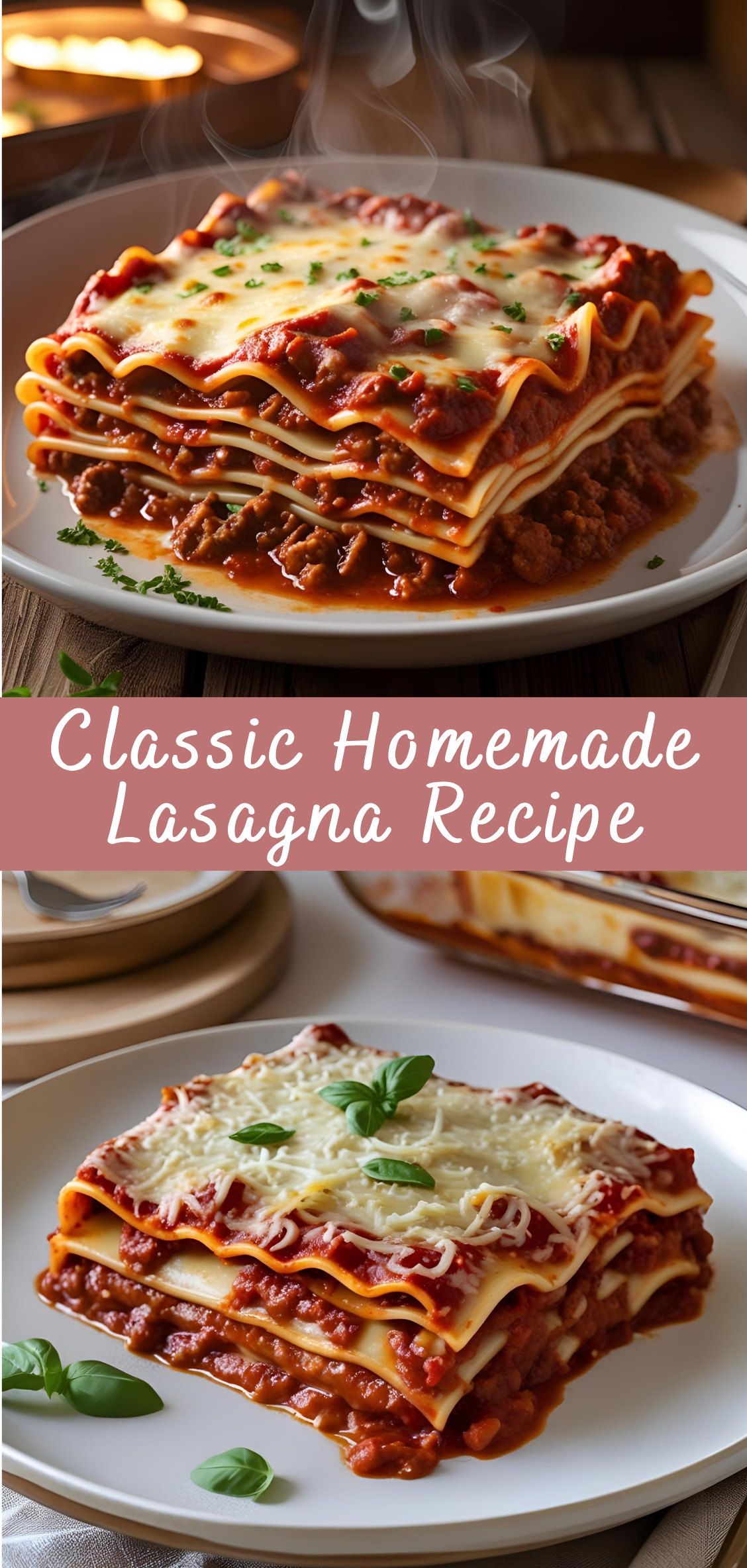Classic Homemade Lasagna Recipe
There are few dishes that capture the heart and soul of home cooking quite like classic homemade lasagna. Rich, layered, and deeply satisfying, this timeless Italian-American favorite is more than just a meal—it’s a culinary ritual. It’s the kind of dish that gathers people around a table, fills a home with irresistible aroma, and carries with it generations of family tradition and cultural history.

Lasagna is more than just pasta and sauce; it’s a celebration of layers—of flavor, of technique, and of time. Every bite is a harmony of silky noodles, robust meat sauce, creamy béchamel or ricotta, and the unmistakable golden cap of melted, bubbling cheese. Its allure lies not only in how delicious it is, but in the care and patience it requires to prepare. Unlike a quick weeknight dinner, lasagna demands intention. You build it, layer by layer, and in doing so, it becomes something greater than the sum of its parts.
The origins of lasagna can be traced back to ancient civilizations, but it was in Italy—particularly in Emilia-Romagna—that it evolved into the rich, layered dish we recognize today. Traditional lasagna alla Bolognese features fresh egg pasta, slow-simmered ragù, béchamel sauce, and Parmigiano-Reggiano. In the United States and other parts of the world, variations have emerged to reflect local tastes and ingredients, often substituting ricotta for béchamel or incorporating vegetables, herbs, and different cheeses.
Regardless of the version, what remains universal is the emotional weight this dish carries. Lasagna is the centerpiece at holidays, Sunday suppers, birthdays, and comforting meals during hard times. It’s the dish you make to show love, to impress guests, or to freeze for a future family gathering. It’s filling, familiar, and—when done right—absolutely unforgettable.
In this comprehensive guide, we’re going to explore every detail of making the perfect classic homemade lasagna. You’ll learn how to prepare a deeply flavorful meat sauce from scratch, how to choose the right noodles and cheeses, and how to layer and bake your lasagna so that each slice holds together beautifully. We’ll also cover variations for dietary needs, storage and reheating techniques, common mistakes to avoid, and some regional and historical context to deepen your appreciation for this beloved dish.
Whether you’re making lasagna for the first time or returning to an old family favorite, this recipe guide will offer both instruction and inspiration. By the time you pull your bubbling masterpiece out of the oven, you won’t just have dinner—you’ll have created something meaningful, something memorable.
Step-by-Step Instructions for Classic Homemade Lasagna
Step 1: Gather Your Ingredients
Before you begin assembling, gather everything you’ll need. A successful lasagna depends on high-quality components prepared with care. Below are the core components we’ll prepare separately before assembling the dish:
Ingredients
For the Meat Sauce (Ragù):
-
2 tablespoons olive oil
-
1 medium yellow onion, finely diced
-
4 garlic cloves, minced
-
1 lb ground beef (80/20 recommended)
-
1/2 lb ground pork or Italian sausage (optional, for depth of flavor)
-
1/4 cup tomato paste
-
1/2 cup dry red wine (optional but recommended)
-
1 can (28 oz) crushed tomatoes
-
1 can (15 oz) tomato sauce
-
1 teaspoon sugar (balances acidity)
-
1 teaspoon dried oregano
-
1 teaspoon dried basil
-
Salt and freshly ground black pepper, to taste
-
1/4 cup chopped fresh parsley or basil (optional)
For the Cheese Mixture (Ricotta Layer):
-
15 oz whole-milk ricotta cheese
-
1 large egg
-
1/2 cup grated Parmesan cheese
-
1 tablespoon chopped fresh parsley
-
Salt and pepper, to taste
For the Pasta Layers:
-
12 lasagna noodles (regular or no-boil)
-
Salt, for boiling water (if using traditional noodles)
-
Olive oil or cooking spray (to prevent sticking)
For the Cheese Topping:
-
2 cups shredded mozzarella cheese
-
1/4 cup additional Parmesan cheese
Step 2: Make the Meat Sauce (Ragù)
This slow-simmered meat sauce is the heart of the lasagna, rich and deeply flavorful.
-
Sauté Aromatics:
Heat olive oil in a large saucepan or Dutch oven over medium heat. Add diced onion and cook until soft and translucent, about 5–7 minutes. Add minced garlic and sauté for another 30 seconds until fragrant. -
Brown the Meat:
Add ground beef and pork (or sausage) to the pan. Break up the meat with a wooden spoon and cook until browned, about 8–10 minutes. Drain off excess fat if necessary. -
Deglaze with Wine (Optional):
Pour in the red wine to deglaze the pan, scraping up any browned bits from the bottom. Let it simmer for 2–3 minutes until slightly reduced. -
Add Tomato Paste and Cook:
Stir in the tomato paste and cook for 1–2 minutes to deepen its flavor. -
Add Tomatoes and Seasoning:
Pour in crushed tomatoes and tomato sauce. Stir to combine. Add sugar, dried herbs (oregano, basil), salt, and pepper. -
Simmer Slowly:
Reduce heat to low. Cover partially and let the sauce simmer for at least 30–45 minutes, stirring occasionally. The longer it simmers, the richer it becomes. For a deep, complex flavor, let it simmer for up to 1.5 hours. -
Adjust Seasoning:
Taste and adjust salt and pepper as needed. Stir in fresh parsley or basil at the end, if using. Set sauce aside.
Step 3: Prepare the Ricotta Mixture
-
Combine Ingredients:
In a medium mixing bowl, add ricotta cheese, egg, Parmesan, chopped parsley, and a pinch of salt and pepper. -
Mix Well:
Stir until fully combined and creamy. This mixture will provide the creamy, rich layer that contrasts the hearty sauce.
Step 4: Boil the Lasagna Noodles (Skip if Using No-Boil)
-
Bring a Large Pot of Water to a Boil:
Salt the water generously. Add lasagna noodles and cook according to package instructions until al dente (firm to the bite). -
Prevent Sticking:
Drain the noodles and lay them flat on a clean kitchen towel or parchment paper. You can also drizzle with a bit of olive oil to prevent sticking.
Step 5: Assemble the Lasagna
Preheat oven to 375°F (190°C).
Use a 9×13 inch baking dish for a traditional lasagna with 3 layers.
Layering Order:
-
First Layer (Sauce):
Spread 1 cup of meat sauce evenly on the bottom of the dish. This prevents the noodles from sticking and ensures even moisture. -
Second Layer (Noodles):
Place 3–4 noodles lengthwise, slightly overlapping. Trim if needed to fit. -
Third Layer (Ricotta):
Spread one-third of the ricotta mixture evenly over the noodles. -
Fourth Layer (Meat Sauce):
Spoon another layer of meat sauce on top (about 1 to 1.5 cups). -
Fifth Layer (Mozzarella):
Sprinkle about 1/2 to 2/3 cup shredded mozzarella over the sauce. -
Repeat Layers:
Continue layering—noodles, ricotta, sauce, mozzarella—until you’ve used all components. Usually 3 full layers. Reserve a generous amount of mozzarella for the top. -
Final Layer:
Top final noodle layer with remaining sauce, mozzarella, and Parmesan.
Step 6: Bake the Lasagna
-
Cover with Foil:
Tent foil over the dish, ensuring it doesn’t touch the cheese (you can use toothpicks if needed). This helps steam the noodles and prevents burning. -
Bake Covered:
Bake for 25–30 minutes. -
Uncover and Brown:
Remove foil and bake for an additional 15–20 minutes, until the top is golden and bubbling. You can broil for 1–2 minutes for extra browning, but watch closely. -
Rest Before Serving:
Let the lasagna rest at room temperature for 15–20 minutes before slicing. This helps the layers set and makes for cleaner servings.
Step 7: Serve and Enjoy
Cut into squares and serve hot. Pair with a simple green salad, garlic bread, or roasted vegetables. A glass of red wine like Chianti or Sangiovese pairs beautifully with the rich flavors of the lasagna.
Classic Homemade Lasagna Recipe
There are few dishes that capture the heart and soul of home cooking quite like classic homemade lasagna. Rich, layered, and deeply satisfying, this timeless Italian-American favorite is more than just a meal—it’s a culinary ritual. It’s the kind of dish that gathers people around a table, fills a home with irresistible aroma, and carries with it generations of family tradition and cultural history.
Ingredients
- Meat Sauce:
- 1 lb ground beef (or ½ lb beef + ½ lb Italian sausage)
- 1 small onion, diced
- 3–4 garlic cloves, minced
- 1 (28 oz) can crushed tomatoes
- 2 tbsp tomato paste
- 1 (15 oz) can tomato sauce
- 1 tsp sugar (optional, to balance acidity)
- 2 tsp dried basil
- 1 tsp Italian seasoning
- Salt and pepper to taste
- Cheese Layer:
- 15 oz ricotta cheese
- 1 large egg
- 1/4 cup grated Parmesan cheese
- 1 tbsp chopped fresh parsley (or 1 tsp dried)
- Other Layers:
- 9–12 lasagna noodles (regular or oven-ready)
- 3 cups shredded mozzarella cheese
- Extra grated Parmesan (for topping)
Instructions
1. Make the Meat Sauce:
- In a large skillet over medium heat, cook ground beef, onion, and garlic until meat is browned and onion is soft.
- Drain excess fat if needed.
- Stir in crushed tomatoes, tomato paste, tomato sauce, sugar, basil, Italian seasoning, salt, and pepper.
- Simmer for 20–30 minutes, stirring occasionally.
2. Prepare the Cheese Mixture:
- In a bowl, mix ricotta, egg, Parmesan, and parsley. Set aside.
3. Cook the Noodles (if not using oven-ready):
- Boil noodles according to package directions until al dente. Drain and lay flat on a towel to prevent sticking.
4. Assemble the Lasagna:
- Preheat oven to 375°F (190°C).
- In a 9x13-inch baking dish, spread a thin layer of meat sauce.
- Layer 3–4 noodles over the sauce.
- Spread 1/3 of the ricotta mixture over the noodles.
- Add 1/3 of the meat sauce, then 1 cup mozzarella.
- Repeat layers two more times: noodles, ricotta, sauce, mozzarella.
- Finish with noodles, remaining sauce, and remaining mozzarella. Sprinkle extra Parmesan on top.
5. Bake:
- Cover with foil (to prevent sticking, spray underside of foil with cooking spray).
- Bake for 25 minutes, then uncover and bake 20 more minutes until bubbly and golden.
- Let rest for 15–20 minutes before slicing (important for clean layers!).
Notes
- Make-ahead: Assembles great a day in advance. Cover and refrigerate, then bake when ready.
- Veggie option: Substitute meat with sautéed mushrooms, spinach, or zucchini.



